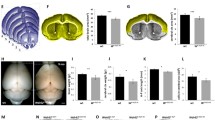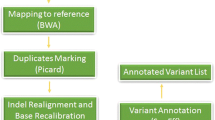Abstract
Neural progenitor proliferation and migration influence brain size during neurogenesis. We report an autosomal recessive microcephaly syndrome cosegregating with a homozygous balanced translocation between chromosomes 3p and 10q, and we show that a position effect at the breakpoint on chromosome 3 silences the eomesodermin transcript (EOMES), also known as T-box-brain2 (TBR2). Together with the expression pattern of EOMES in the developing human brain, our data suggest that EOMES is involved in neuronal division and/or migration. Thus, mutations in genes encoding not only mitotic and apoptotic proteins but also transcription factors may be responsible for malformative microcephaly syndromes.


Similar content being viewed by others
References
Barkovich, A.J. et al. Neurology 65, 1873–1887 (2005).
Kimura, N. et al. Brain Res. Dev. 115, 183–193 (1999).
Bulfone, A. et al. Mech. Dev. 84, 133–138 (1999).
Russ, A.P. et al. Nature 404, 95–99 (2000).
Englund, C. et al. J. Neurosci. 25, 247–251 (2005).
Hevner, R.F. et al. Neurosci. Res. 55, 223–233 (2006).
Fougerousse, F. et al. Hum. Mol. Genet. 9, 165–173 (2000).
Davis, R.L. & Turner, D.L. Oncogene 20, 8342–8357 (2001).
Anthony, T.E. et al. Neuron 41, 881–890 (2004).
Pearce, E.L. et al. Science 302, 1041–1043 (2003).
Takemoto, N. et al. J. Immunol. 177, 7515–7519 (2006).
Fernandez, B.A. et al. Clin. Genet. 68, 349–359 (2005).
Strumpf, D. et al. Development 132, 2093–2102 (2005).
Fink, A. et al. J. Neurosci. 26, 3066–3076 (2006).
Acknowledgements
The authors thank the microcephaly syndrome family for their participation. We thank Z. Al-Houssaini, N. Bahi-Buisson, C. Chirol, M. Clément-Ziza, N. Moussok, A. Pelet, S. Romana, C. Schatz and M. Vekemans for their assistance. This study was funded by INSERM, Agence Nationale de la Recherche and the Fondation pour le Recherche Médicale.
Author information
Authors and Affiliations
Corresponding author
Ethics declarations
Competing interests
The authors declare no competing financial interests.
Supplementary information
Supplementary Fig. 1
Clinical features. (PDF 387 kb)
Supplementary Fig. 2
FISH analyses of BACs RP11-9A14 (chromosome 3p) and RP11-102H24 (chromosome 10q). (PDF 139 kb)
Supplementary Fig. 3
Sequencing of the junction fragments on 3p24 and 10q22. (PDF 426 kb)
Supplementary Table 1
BAC probes encompassing the 3p and 10q translocation breakpoint. (PDF 65 kb)
Supplementary Table 2
Methods for RT-PCR analysis of candidate genes on chromosome 3p and 10q. (PDF 108 kb)
Rights and permissions
About this article
Cite this article
Baala, L., Briault, S., Etchevers, H. et al. Homozygous silencing of T-box transcription factor EOMES leads to microcephaly with polymicrogyria and corpus callosum agenesis. Nat Genet 39, 454–456 (2007). https://doi.org/10.1038/ng1993
Received:
Accepted:
Published:
Issue Date:
DOI: https://doi.org/10.1038/ng1993
- Springer Nature America, Inc.
This article is cited by
-
Transcriptomes of Clusterin- and S100B-transfected neuronal cells elucidate protective mechanisms against hypoxia and oxidative stress in the hooded seal (Cystophora cristata) brain
BMC Neuroscience (2022)
-
Features of the Development of the Human Cerebral Cortex during the Second Trimester of Gestation
Neuroscience and Behavioral Physiology (2022)
-
Sylvian fissure development is linked to differential genetic expression in the pre-folded brain
Scientific Reports (2020)
-
Deconstructing cortical folding: genetic, cellular and mechanical determinants
Nature Reviews Neuroscience (2019)
-
Zika Virus Infects Intermediate Progenitor Cells and Post-mitotic Committed Neurons in Human Fetal Brain Tissues
Scientific Reports (2017)





